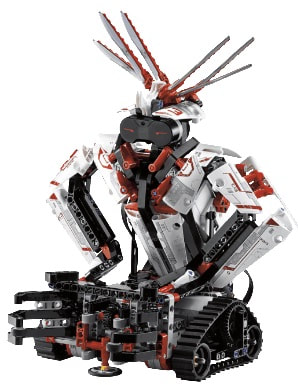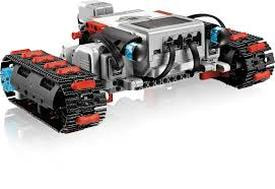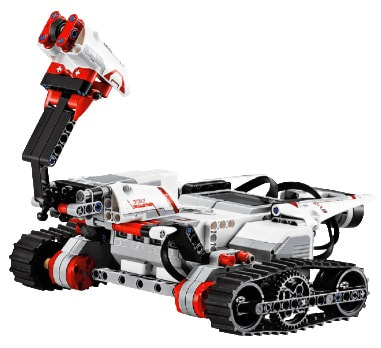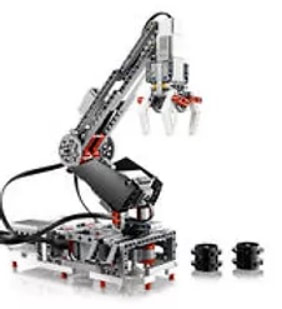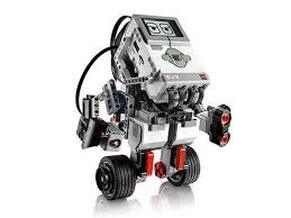MORE ABOUT ROBOTS
HOW THEY USE ROBOTS
Everybody constructs robots from an unlimited number possibilities.
Anybody can build their own favorite and exciting designs.
Students can seek to complete challenges and receive many certificates of accomplishment.
(Certificates are provided at the end of each session)
SOME CONCEPTS
Why is spatial awareness important in robotics?
Why is mathematics necessary for programming robots?
How can problem-solving strategies be used to develop and produce technological and programming solutions?
Everybody constructs robots from an unlimited number possibilities.
Anybody can build their own favorite and exciting designs.
Students can seek to complete challenges and receive many certificates of accomplishment.
(Certificates are provided at the end of each session)
SOME CONCEPTS
Why is spatial awareness important in robotics?
Why is mathematics necessary for programming robots?
How can problem-solving strategies be used to develop and produce technological and programming solutions?
More about The Sumo challenges.
Sumo is a Japanese wrestling contest in which two participants challenge each other within a defined area to see who can be the last standing.
Could You Be a Sumo Robot Wrestler?
Robo-Sumo, like the Japanese wrestling contest, is the challenge in which two robots challenge each other within a fixed space ("Ring").
Important strategies for winning a match: Low stance in relation to how it affects center of gravity.
Students discuss ideas about what they need to do to modify their robots to be the best Sumo wrestler it can be (direct students to think about mass and center of gravity as discussed above)
1. Students will apply basic robotics skills in a friendly and fun environment
2. Students will recognize the effect of center of gravity and mass distribution on the performance of their robot
3. Students will discover the importance of combining programming and construction effectively
So Many Words in Robotics
Some C Words Below
Some C Words Below
Copying code (from yourself, a book, worksheet or other published source) to
do one small ask over every time you do that task
writing code so the task is generalized
using subroutines or making your own icons (see Inventor 4) so you don’t
have to cut and paste the code – you tell the RCX to use a particular piece of
code again and again.
Programmers in general do not get in trouble for copying. There are lots of algorithms
published for people to use.
compromise - sometimes means “I give a little, you give a little, we meet in the middle”,
sometimes means “I get my way this time, you get your way another time.” -- settling a
disagreement by arbitration (getting a third person to help you) and/ or each giving up
part of what you want so you can both have most of what you want. A really good
compromise is when you both feel like you’ve won.
“com” means together – “promise” – compromising is a promise to work together.
Active listening techniques are often an important part of reaching a compromise.
Computer - a computer is a machine that executes instructions - a computer is a
machine that does what you tell it to do, which may be different than what you want it to
do – think of 2 year olds. Very literal.
A computer accepts data, works on it by doing arithmetic or comparisons at high speed,
and gives the results, often as information printed on a screen or paper.
Consensus – a group agreement reached through convincing and compromise, not
majority rule or coach fiat. The preferred, but not always achievable, state. See file
Counters – Inventor Level 4. A way to keep track of lines crossed, rotations made,
number of bumps.
Critical thinking - thinking something through comparing various points to criteria, not
just random criticism (putting something down).
Vocabulary & Concepts
thinking and evaluation that can seem like putdowns. Try to mix in praise, and get the
kids to do so also. “That’s a really good idea. A great place to start. We can make it
even better if we ...”
Cross-brace, reinforce – adding a few additional pieces to hold a structure together, to
make it stronger. Cross-bracing pieces often join two pieces cross-wise. The
Scooterbot has some excellent examples of cross-bracing. So does the Gear Frame
(aka Gear Box). See files StrongStruct, MakingSqStr, LegoCrossb, GearFrame.
Debug – the term arose when one of the Navy’s early computers kept failing. The
problem was eventually traced to a dead moth shorting out a circuit. So now, following
through the behavior and interactions of hardware and software to achieve a
repeatable, desired, correct, verifiable result is called debugging.
Diameter, radius, circumference – The diameter of a circle is the distance across it
through the center of the circle. The radius is the distance from the center to the
outside. The circumference is the distance around the outer edge. Put the kids in a
circle with one kid in the middle. Have Center hold hands with the kids on either side
and stretch out – the rest fill in the edge of the circle to that size – the three kids holding
hands are the diameter. Have Center drop one hand – the remaining handholders are
radius. Have Center drop that hand, and everybody else hold hands – they are the
circumference.
Differential – a gear assembly that is usually used in cars so that two axles can turn at
different speeds and be powered by the same motor. There’s also one special LEGO
differential gear; the individual gear and the whole subassembly can both be called the
differential.
Divide & Conquer – a method of problem identification and attack. Try to divide big
problems into small problems, tasks, and tests. Try to divide big jobs into smaller tasks,
tests, and between team members. See Failure. See files DivideandConquer,
ScientificMethod.
Documentation - the paper trail that helps track what is known, what you’ve added to
your knowledge, what you have permission for, what’s been checked, what you’ve really
tested.
Dry run – running a test in not-real conditions. Often for a robot, this means holding it
upside down in your hand and running the program, waving a finger over the light
sensor or bumping the touch sensor to see if the robot responds as predicted by your
understanding of the program. Dry runs are not appropriate for all testing but are a
great help for a large percentage of problems and small adjustments.
do one small ask over every time you do that task
writing code so the task is generalized
using subroutines or making your own icons (see Inventor 4) so you don’t
have to cut and paste the code – you tell the RCX to use a particular piece of
code again and again.
Programmers in general do not get in trouble for copying. There are lots of algorithms
published for people to use.
compromise - sometimes means “I give a little, you give a little, we meet in the middle”,
sometimes means “I get my way this time, you get your way another time.” -- settling a
disagreement by arbitration (getting a third person to help you) and/ or each giving up
part of what you want so you can both have most of what you want. A really good
compromise is when you both feel like you’ve won.
“com” means together – “promise” – compromising is a promise to work together.
Active listening techniques are often an important part of reaching a compromise.
Computer - a computer is a machine that executes instructions - a computer is a
machine that does what you tell it to do, which may be different than what you want it to
do – think of 2 year olds. Very literal.
A computer accepts data, works on it by doing arithmetic or comparisons at high speed,
and gives the results, often as information printed on a screen or paper.
Consensus – a group agreement reached through convincing and compromise, not
majority rule or coach fiat. The preferred, but not always achievable, state. See file
Counters – Inventor Level 4. A way to keep track of lines crossed, rotations made,
number of bumps.
Critical thinking - thinking something through comparing various points to criteria, not
just random criticism (putting something down).
Vocabulary & Concepts
thinking and evaluation that can seem like putdowns. Try to mix in praise, and get the
kids to do so also. “That’s a really good idea. A great place to start. We can make it
even better if we ...”
Cross-brace, reinforce – adding a few additional pieces to hold a structure together, to
make it stronger. Cross-bracing pieces often join two pieces cross-wise. The
Scooterbot has some excellent examples of cross-bracing. So does the Gear Frame
(aka Gear Box). See files StrongStruct, MakingSqStr, LegoCrossb, GearFrame.
Debug – the term arose when one of the Navy’s early computers kept failing. The
problem was eventually traced to a dead moth shorting out a circuit. So now, following
through the behavior and interactions of hardware and software to achieve a
repeatable, desired, correct, verifiable result is called debugging.
Diameter, radius, circumference – The diameter of a circle is the distance across it
through the center of the circle. The radius is the distance from the center to the
outside. The circumference is the distance around the outer edge. Put the kids in a
circle with one kid in the middle. Have Center hold hands with the kids on either side
and stretch out – the rest fill in the edge of the circle to that size – the three kids holding
hands are the diameter. Have Center drop one hand – the remaining handholders are
radius. Have Center drop that hand, and everybody else hold hands – they are the
circumference.
Differential – a gear assembly that is usually used in cars so that two axles can turn at
different speeds and be powered by the same motor. There’s also one special LEGO
differential gear; the individual gear and the whole subassembly can both be called the
differential.
Divide & Conquer – a method of problem identification and attack. Try to divide big
problems into small problems, tasks, and tests. Try to divide big jobs into smaller tasks,
tests, and between team members. See Failure. See files DivideandConquer,
ScientificMethod.
Documentation - the paper trail that helps track what is known, what you’ve added to
your knowledge, what you have permission for, what’s been checked, what you’ve really
tested.
Dry run – running a test in not-real conditions. Often for a robot, this means holding it
upside down in your hand and running the program, waving a finger over the light
sensor or bumping the touch sensor to see if the robot responds as predicted by your
understanding of the program. Dry runs are not appropriate for all testing but are a
great help for a large percentage of problems and small adjustments.
Copying code (from yourself, a book, worksheet, or other published source) to
do one small ask over every time you do that task
writing code so the task is generalized
using subroutines or making your icons (see Inventor 4) so you don’t
have to cut and paste the code – you tell the RCX to use a particular piece of
code again and again.
Programmers in general do not get in trouble for copying. There are lots of algorithms
published for people to use.
compromise - sometimes means “I give a little, you give a little, we meet in the middle”,
sometimes means “I get my way this time, you get your way another time.” -- settling a
disagreement by arbitration (getting a third person to help you) and/ or each giving up
part of what you want so you can both have most of what you want. A really good
compromise is when you both feel like you’ve won.
“com” means together – “promise” – compromising is a promise to work together.
Active listening techniques are often an important part of reaching a compromise.
Computer - a computer is a machine that executes instructions - a computer is a
machine that does what you tell it to do, which may be different than what you want it to
do – think of 2-year-olds. Very literal.
A computer accepts data, works on it by doing arithmetic or comparisons at high speed,
and gives the results, often as the information printed on a screen or paper.
Consensus – a group agreement reached through convincing and compromise, not
majority rule or coach fiat. The preferred, but not always achievable, state.
Critical-thinking - thinking something through comparing various points to criteria, not
just random criticism (putting something down).
Cross-brace, reinforce – adding a few additional pieces to hold a structure.re together, to
make it stronger. Cross-bracing pieces often join two pieces cross-wise.
Copying code (from yourself, a book, worksheet, or other published source) to
do one small ask over every time you do that task
writing code so the task is generalized
using subroutines or making your icons (see Inventor 4) so you don’t
have to cut and paste the code – you tell the RCX to use a particular piece of
code again and again.
Programmers in general do not get in trouble for copying. There are lots of algorithms
published for people to use.
compromise - sometimes means “I give a little, you give a little, we meet in the middle”,
sometimes means “I get my way this time, you get your way another time.” -- settling a
disagreement by arbitration (getting a third person to help you) and/ or each giving up
part of what you want so you can both have most of what you want. A really good
compromise is when you both feel like you’ve won.
“com” means together – “promise” – compromising is a promise to work together.
Active listening techniques are often an important part of reaching a compromise.
Computer - a computer is a machine that executes instructions - a computer is a
machine that does what you tell it to do, which may be different than what you want it to
do – think of 2-year-olds. Very literal.
A computer accepts data, works on it by doing arithmetic or comparisons at high speed,
and gives the results, often as the information printed on a screen or paper.
Consensus – a group agreement reached through convincing and compromise, not
majority rule or coach fiat. The preferred, but not always achievable, state.
Critical-thinking - thinking something through comparing various points to criteria, not
just random criticism (putting something down).
Cross-brace, reinforce – adding a few additional pieces to hold a structure.re together, to
make it stronger. Cross-bracing pieces often join two pieces cross-wise.

